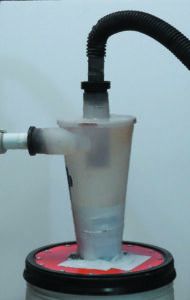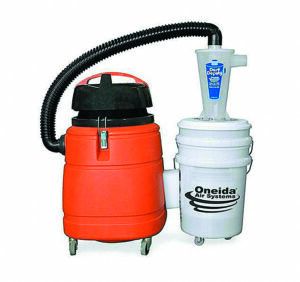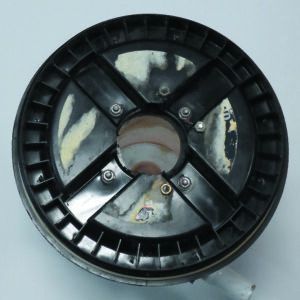In “Dustless Sanding,” (see PS April 2016), we described a simple modification to a 5-gallon bucket that would make collecting dust from bottom painting or slurping water from the bilge easier. It didn’t catch all of the fine dust, and when sucking mountains of sawdust, we couldn’t fill the bucket much past half-full without dust carrying into the vacuum. So we started playing with two commercial versions, and found a lot to like.
OBSERVATIONS
Dust separators are better at catching coarse dust, like sawdust, than fine paint-sanding dust. You will still need a fine dust filter on your vacuum.
If the small inlets on the sander are blocked, they can create suction that will cause the bucket to collapse. The bucket will pop back out without harm, but the jolt can cause the bucket to tip over. That is why screwtop lids are preferable, and why you should always secure the bucket and dust catcher assembly.
We’ve been using the Dust Deputy in our home shop for several years. It does such a good job of keeping dust out of the vacuum that we power our various dust collectors (Dust Deputy, Dust Stopper, and the home made dust-collector) with a 2.5-horsepower Hover Porta-Power hand-carry home vacuum that we bought at a thrift store for $15. I also have a 2.2 hp 9-gallon Shop Vac, but that is reserved for wet work because it is considerably louder (89 dB(A) vs. 74 dB(A)).
The bucket on the DIY version intercepts about 75-percent of antifouling paint sanding dust, and the Dust Deputy and Duststopper suck up about 90 percent. Filter clogging with the Porta-Power has dropped from a clogged filter every hour to less than one clog per day. The dust collector eliminates the need to clean the wet/ dry vacuum filter, greatly extending the usable life of these expensive fine dust filters.
If you want to splurge on a top-ofthe- line unit, the local yard swears by the Kerrick Roky 103 dust collector, which is used by all their work crews. In this tough environment, these heavy duty collectors last about 10 times longer than homeowner-grade wet/dry vacs. They are significantly quieter (67 dB), but they cost about $500. The Kerrick looks like a wet/dry vacuum, but it is dry-only. The 103 has been discontinued, but there are still some being sold online, and Kerrick makes similar models.
HEARING PROTECTION
The decibel scale (dB) is logarithmic, with every 10 units equal to a doubling of sound energy and damage potential, so 89 dB is about 3 times as loud as 74 dB. A smaller vacuum may not require hearing protection, while a larger wet/dry vacuum will. Using a long suction hose reduces noise by moving the vacuum farther away. Because the airflow through the hose is low when sanding, there is no reduction in suction. Put the main unit on the other side of the keel or behind your car. We used a 25-foot flexible 1.25-inch sump pump discharge hose as an extension. By centrally locating the vacuum, we can reach the whole boat, inside and out, without moving the vacuum. Aim the noisy exhaust away from the work area, and consider adding either an exhaust muffler or inserting the 2.5-inch hose you are not using into the exhaust and pointing it away from you.
HOSE DETAILS
The upsides of the sump pump hose extensions are that they are light, cheap, and easy to work with. The downside is that the hose whistles (actually shrieks) at high flow because of the corrugations. This is not a problem when sanding or using a crevice tool, because the flow is restricted, but you’ll need ear plugs when using the unrestricted hose end for cleaning inside a cabin. We’re still looking for an affordable substitute to the noisy corrugated sump pump hose, which cost only $15.
We’ve seen a lot of brands of wet/dry vacs in the boat yard. For occasional use, Shop Vacuum, Craftsman, and Rigid all seem to hold well enough. The most common cause of failure is overheating, caused by running long hours with restricted air flow, which can overheat the motor, or by dust clogging the motor.
The motor is cooled by the vacuum air flow, and clogged bags and restrictions from the sander choke off this air. Dust builds up from using bags or filters that are not fine enough to catch the dust. In addition to noise, excess horsepower is also a problem. Because the airflow is restricted by the holes in the sandpaper, there often isn’t enough airflow to cool a big motor.
A smaller vacuum is usually sufficient, because you aren’t pulling air through a fat hose. Even when cleaning up cabin projects, you just don’t need the super airflow that a 2.5-inch main hose and a lot of horsepower can provide. A good strong suction through a 1.25-inch hose is enough and it’s much easier to work with in the cabin.
DUST DEPUTY
Sold by Oneida Air Systems, this bucket- sized cyclone is similar to those used in sawmill dust collectors and Dyson vacuums. It is highly efficient on coarse dust, and allows practically nothing through the vacuum filter. With fine sanding dust from bottom paint, it still stops about 90 percent of the dust. We liked it best when installed in a screwtop lid, which complicates assembly, but makes it more versatile.
Our Dust Deputy cracked during use, but that was our fault. Its greater height makes the bucket tippy and we didn’t secure as we should have. We tugged on the hose while working and that yanked it out of the bed of a pickup truck. Dumb, but duct tape put it back together and we have used it for several years since. The solution is to tie it to something, like a drill-press stand at home, or a boat stand in the field.
Bottom line: High efficiency on fine dust and good capacity make it our Best Choice.
THE DUST STOPPER
Made by Better Faster, Easier, the Dust Stopper is sold at Home Depot. Setup is easy. You slap it on a bucket and get started. You will need adapters for the 1.25-inch hose. It is less tippy, equally efficient on fine dust, and is easily adapted to screw-top lids.
Bottom line: It would be our Best Choice if it fit a screw top lid. Maybe you can adapt it.
DIY BUCKET TRAP
We described this home-made system in great detail in the April 2016 report. Dust capture efficiency is OK, but not as good as either of the store-bought devices. It doesn’t hold as much sawdust without carryover. On the other hand, it’s cheap, unbreakable, compact, and we still use it for messy jobs. See “Dustless Sanding,” April 2016. About $15 in parts and an hour to assemble.
Bottom line: A Budget Buy.
RIGID HD0900 WET/DRY VACUUM
This is one of the most common vacuums at the boatyard, and it does a serviceable job on a budget. The downsides are excessive noise and high cost of filters. Bag filters that go over the standard filter are only about $7 each but they foul frequently. Replacement fine dust filters are about $25 and last several days. The Rigid’s advantage is simplicity, since it is all-in-one unit.
Bottom line: Recommended.
RIGID WD4070 WET/DRY VACUUM
The local pros swear by this one. It is smaller that the other Rigid models, but you don’t need much volume to catch sanding dust. It is also more powerful (and louder). Replacement fine dust filters are about $16 and last several days.
Bottom line: Recommended.
CONCLUSIONS
We like dust diverting devices like the Dust Deputy and Dust Stopper for bottom jobs and for liquids. On bottom jobs, it saves the mess of cleaning filters. When dealing with liquids, it is easier to haul and dump a bucket with a screw top than a bulky Shop Vacuum. Combine the Dust Deputy with a reliable vacuum and a few extra buckets and you can tackle the messiest job.
CONTACTS
DUST DEPUTY,
RIGID TOOLS,
ONEIDA,
HOOVER,
VALUE GUIDE: BOATYARD VACUUM ATTACHMENTS
| MANUFACTURER | MODEL | DUST CAPACITY | EFFICIENCY | FLOW | INITIAL SETUP | COMMENTS | COST |
|---|---|---|---|---|---|---|---|
| DUST COLLECTION SYSTEMS | |||||||
| DIY BUCKET DUST COLLECTOR | DIY | 3 gallons | Good | Varies* | 1 hour | Flow depends on fitting size; most compact to store; works with a compact household vacuum; add $8 for screw-top lid (if desired); add $4 for bucket; works with a wet/dry vacuum; you can exchange buckets for more capacity | ~ $15 |
| ONEIDA AIR SYSTEMS | Dust Deputy | 4 gallons | Excellent | High | 1-hour | Adapters required for 1-inch hose; most efficient with fine paint dust; tippy (strap down); works with a compact household vacuum add $8 for screw-top lid if desired; add $4 for bucket can be used with a wet/ dry vacuum; you can exchange buckets for more capacity | $55 |
| FASTER, BETTER, EASIER | Duststopper | 4 gallons | Very good | High | none | Adapters required for 1-inch hose, not compatible with screw-top lid; works with a compact household vacuum; add $4 for bucket; works with a wet/dry vacuum can exchange buckets for more capacity | $41 |
| WET-DRY VACUUMS | |||||||
| RIGID | HD 0900 | 4 gallons | Very good | High | none | Noisy (86 dB at 6 feet); comes with adapters for 1-inch hose; replacement fine dust filter $25 | $85 |
| RIGID | WD 4070 | 2 gallons | Very good | High | none | Noisy (88 dB at 6 feet); replacement fine dust filter costs $16 | $99 |
| CONVENTIONAL VACUUM | |||||||
| HOOVER | Porta-Power | 0.1 gallon | Very good | High | none | Quieter (76 dB at 6 feet); reusable filter element: not a wet/dry vacuum, but it is commercial grade unit | $275 |
It’s easy to screw the Dust Deputy to a plain bucket lid. It also impractical because unless locked down, it falls off, leaks vacuum, and leak contents in transport. Our solution was to install a screw-top lid on the bucket, but that complicates things because screw top lids are not flat and the Dust Deputy won’t seal. But this is solvable:
Cut a disk from an old bucket lid or scrap plywood and screw it to the topside of the lid to level it, bedding it with polyurethane sealant. Through bolt the Deputy flange to the lid, recognizing that the bolts will vary in length according to the ribs on the lid. You will likely have to drill some new holes in the flange, since the lid rib spacing may interfere.
To accommodate the 1.25-inch hose we prefer, we fitted some rubber grommets left over from an old Shop Vacuum, but PVC fittings and duct tape work just as well.
For $110 you can also buy it as a kit that includes a second bucket, casters for the bucket, and a predrilled lid. Strapped to the side of a Shop Vacuum, it’s a neat setup for the wood shop, but for the boat yard, don’t do it. The screw-top lids are more secure and casters are useless in the boat yard. The supplied 2-inch hose is handy for sucking ups small chunks of wood and gobs of sawdust in the woodshop, but way too big for vacuum sanders and boat work.

1. The black hose on the Dust Deputy goes to the vacuum; the white hose to the sander. Tape seals a crack caused when the bucket fell over.

2. Because the inside of the lid has an irregular thickness, it needs bolts of different lengths.

3. The Dust Deputy kit as it looks when it is assembled. The kit does not include the vacuum.

4. The complete Dust Deputy kit includes wheels and elbow fittings that aren’t essential. We preferred our own converted bucket and lid.

This article first appeared in February of 2022.






































I have been using my 20+ year old Craftsman shop vac for sanding the bottom paint on my 34″ Sea Sprite. For the sanding, I use a (manual) drywall screen sander with vacuum hose adapter to the shop vac hose. They work very well together- the shop vac is set to a medium-low speed and I get virtually no sanding dust in the air, my face, nose, or surroundings. Cleaning the shop vac and hose is a messy pain, but only once/year. I tap out the large shop vac corrugated paper filter (again- messy) but do not have to replace the filter.
^^ Good!
I like extending the hose with a long, cheap, lightweight home sump pump hose. In this way I don’t need to keep moving the vacuum. To MT the hose I shake it out with the vac still running, but I only use it for boat projects, so there is no need to scrupulously clean the inside. I just coil it up and tie it off.